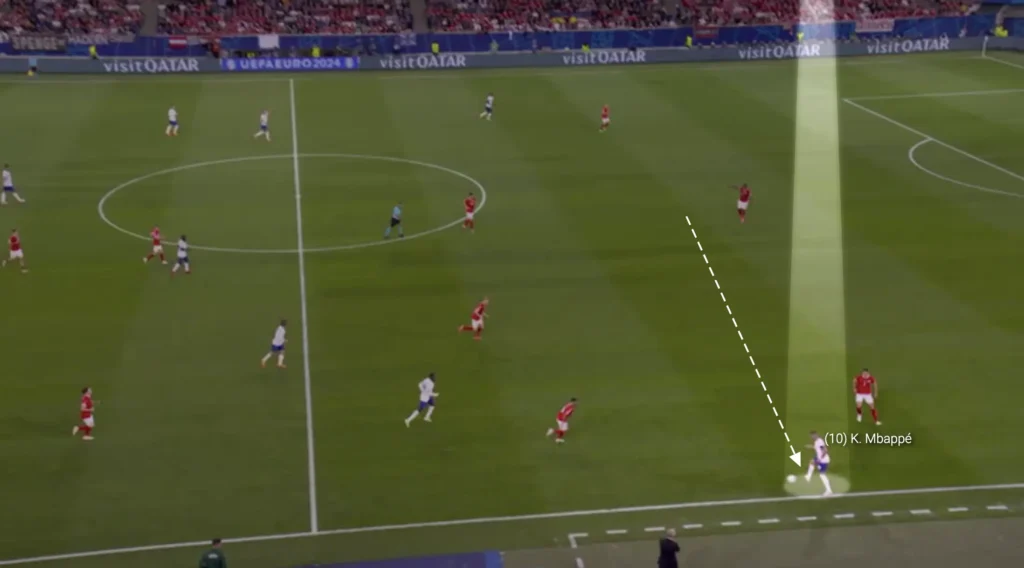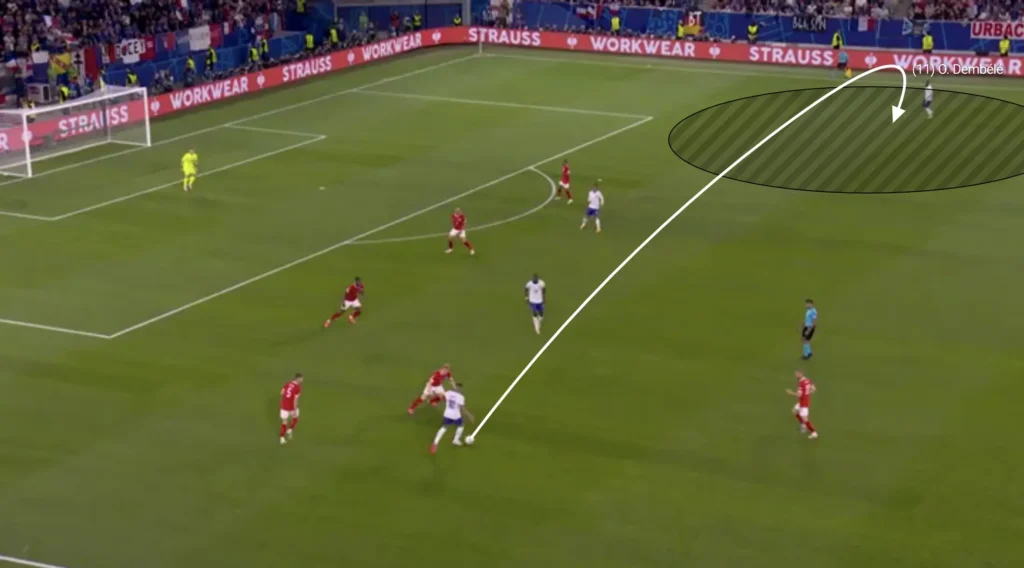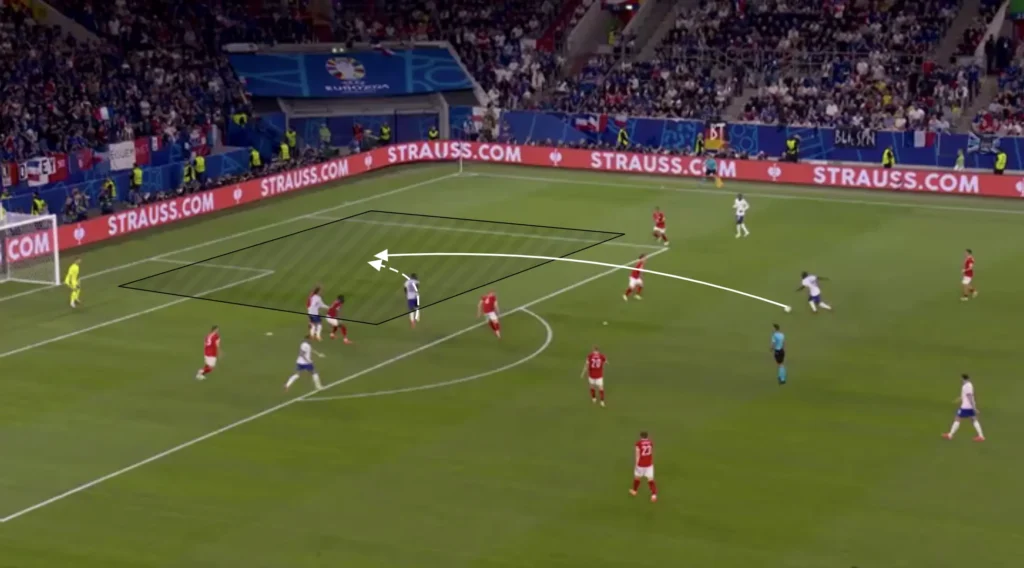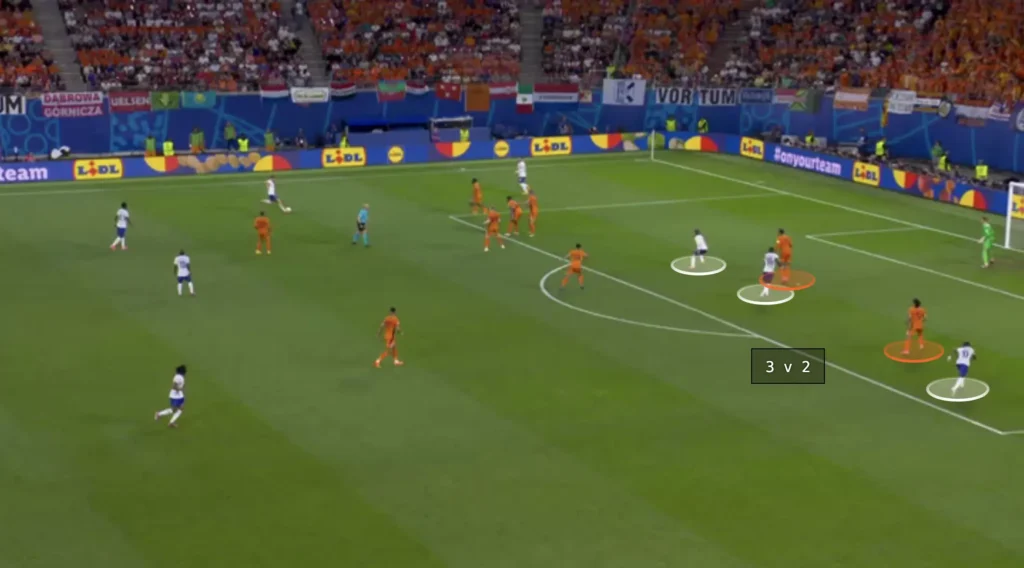Under Didier Deschamps’s astute leadership, France has consistently showcased tactical brilliance on the international stage. Deschamps, a former World Cup-winning captain, has seamlessly transitioned from player to manager, implementing strategies emphasizing defensive solidity and attacking flair. This tactical analysis will delve into the key principles, formations, and player roles that define Deschamps’ French side. By examining the team’s structure and in-game adjustments, we aim to uncover the strategic elements that have propelled France to the pinnacle of international football.
Build-up
In the build-up, Deschamps usually sets his team up in a 1-4-3-3 formation, with a back four, one number-six, two number-eights, and three up front.


Fluidity
France’s fluidity in the build-up phase is a hallmark of their tactical sophistication under Didier Deschamps. Utilizing a flexible approach, the team seamlessly transitions between formations, often starting with a 1-4-3-3 that morphs into a 1-3-2-5 as they progress up the field. This fluidity allows for dynamic movement and positional rotations among the players, creating numerical advantages and disrupting the opposition’s defensive structure. The fullbacks may push high and wide, while midfielders drop deeper or push forward as needed, ensuring constant support and options for the ball carrier. This adaptability facilitates smooth ball progression and maximizes the attacking potential of France’s talented squad, making them a formidable force in the build-up play.
Mbappé’s Role in Deschamps’ Team
Kylian Mbappé is perhaps the most fluid player in this French national team. His free role for France showcases his versatility and creativity on the field. Unrestricted by a fixed position, Mbappé roams across the attacking third, exploiting spaces and creating opportunities. This freedom allows him to drift wide, drop deep, or spearhead the attack as needed.


His pace, dribbling, and keen sense of positioning make him a constant threat, disrupting defensive lines and linking play effectively with his teammates. This dynamic role maximizes Mbappé’s individual talents and enhances France’s overall attacking fluidity, making the team more unpredictable and difficult to defend against.
His teammates also know that he likes to move around and, therefore, try to open as much space for him as possible. For example, when he drops deep, the winger will make a run in behind to pin the nearby defenders. The defenders, concerned about protecting the space in behind, will not jump on Mbappé, giving him the time and space to turn and do something productive with the ball.

Overloads on the Left
Deschamps wants his team to create overloads on the left side in the high build-up. They will come over with many players, often creating numerical advantages, allowing them to beat the opposition’s defense. The players will be very close to each other and use intricate passes to create goalscoring opportunities.


Having the players close to each other creates more options for the ball-holder and less space between the players. Deschamps likes this because it builds good conditions in defensive transitions while making it easier to play through the opposition. Keeping many players close together shortens the distances between them. This shortens the length of the passes, which naturally shortens the time between passes. This means the opposition players will have less time to push up and press, giving the French players more time and control.
Because they have many players on the left side in attack, many teams push over on the left side when defending and leave the right side completely open. This opens up big spaces for the French right-winger Dembele to receive the ball from a long switch.

When Dembele gets the ball he will immediately attack the opposition left-back in a 1v1 situation.

Beating his defender 1v1 is perhaps Dembele’s biggest strength, which is why Deschamps wants to create the overloads on the left side and open up the right. His quick acceleration, close ball control, and unpredictable dribbling make him a constant threat on the wing. Dembélé’s agility allows him to change direction swiftly, often leaving defenders off balance. His skillful use of both feet also enables him to take the ball past his opponents on either side, adding to his versatility and unpredictability.
Give and Go
An influential principle of Deschamps’ France is to always move after passing the ball. Moving after passing the ball is crucial in football because it maintains the fluidity and dynamism of the game. When players move after making a pass, they create new passing options, disrupt the opponent’s defensive structure, and open up spaces for their teammates. This movement ensures that the team retains possession and keeps the opponents guessing, making it harder for them to anticipate and intercept the ball. It also enables quick combination plays and gives the attacking team a numerical advantage in critical areas of the pitch. Ultimately, continuous movement after passing is essential for effective teamwork, creating scoring opportunities, and maintaining a high tempo in the game.
One-Two
An extension of the French players’ constant movement is one-twos. The players always move after passing the ball, giving the player who received the ball the option to give it back in a new space. The one-two is extremely hard to defend and has become a vital tool in France’s high build-up. it facilitates quick ball movement and creates opportunities to break through tightly packed defenses. By executing a one-two, players can exploit small gaps and bypass opponents, often leading to advantageous positions and scoring chances.


Final Third
Attacking the Half-Space
Deschamps’ players usually look to create chances by attacking the space between the opposition center-back and fullback. They primarily do this from the wide areas with underlaps from the midfielders. When the winger receives the ball he will attract the opposition fullback. This opens the space between the fullback and the center-back, which allows a French midfielder to make the underlapping run into this space. The ball can be played to the underlapping player, who can cross the ball into the box or attack his defender in a 1v1 situation.


The winger does not have to play the ball to the underlapping player. The run from the French midfielder will often drag away an opposition defensive midfielder, which opens the space inside. The winger can take the ball inside and shoot or find a pass to a free player in front of the backline.

Deschamps’ team also exploits the space between the center-back and the fullback by playing through-balls from the midfield or backline into a run from an attacker.

Overlaps
France often use the overlap to produce opportunities in the final third. When the France winger gets the ball, the fullback quickly makes the overlap, creating a 2v1 on the wing. If the opposition fullback drops to cover the overlapping run, the winger could cut inside, taking a shot or combining with a midfielder. If the fullback covers the center, the ball can easily be played to the overlapping player, creating a crossing opportunity.

Many Players in the Box
The number-eights and wingers look to make runs into the box when the ball is in the final third, often getting four or five players into these areas to create overloads. The numerical advantages in the box increase the chances of connecting with the cross, as more players present multiple targets for the crosser, making it harder for defenders to mark everyone effectively. Additionally, having multiple players in the box provides options for different types of finishes, whether it’s a header, volley, or a quick tap-in. It also allows for better positioning to react to second balls or rebounds, increasing the likelihood of capitalizing on any defensive errors.


Deschamps also positions many players outside the box, ready for the second balls and cut-backs. They always succeed in pushing down the opposition’s defense, which opens the space in front of the backline. The midfielders will often be found in these spaces with cut-backs, and from there, they can shoot or combine with an attacker to create goalscoring opportunities.

Defending
When defending, Deschamps’ team uses a 1-4-5-1 formation. They look to set up in a mid-block, always trying to close the center, forcing the opposition out wide. Deschamps wants his team to be man-to-man with the opposition midfielders.

This makes their defensive shape very dynamic because they adapt to their opponents. Here, the opposition forces them to be positioned in a 1-4-1-4-1 formation;

While here, the opponent’s shape forces them to be in a 1-4-2-3-1 formation:

The man-to-man system makes it difficult for the opposition to find free players. However, it can confuse and cause issues for the French players when facing fluid teams that often change positions.
Closing the Switch of Play
The French striker is usually high up when defending. He is closing off one of the center-backs, making it difficult for the opposition to switch sides. When a central midfielder breaks out and decides to press one of the center-backs, the other one will be blocked off. This forces the center-back to either play the ball back to the goalkeeper or play it forward where France will come across and win the ball.


High Backline
One tool that helps to be compact is to play with a high backline, making the space to the midfield line as small as possible. France do this and usually try to keep the highest line they can without leaving the space behind them too open. Defending with a high backline involves positioning the defensive line closer to the midfield, rather than near the goalkeeper. This tactic compresses the space available for the opposing team to operate, disrupting their build-up play and increasing the chances of winning the ball back quickly.

A high backline also allows defenders to support the midfield more effectively, creating numerical superiority in central areas and facilitating quicker transitions from defense to attack. However, it requires defenders with good pace and positional awareness to deal with long balls and prevent opposing attackers from exploiting the space behind. This approach demands constant communication and coordination among the backline to maintain a cohesive and effective defensive structure.
Everyone must be in the same line when defending with a high backline to maintain an effective offside trap, ensure cohesive coverage, and reduce gaps that attackers can exploit. A well-aligned defensive line makes it easier to catch opposing forwards offside, preventing them from receiving the ball in dangerous positions.
Squeezing the Pitch
Deschamps always wants his team to squeeze the pitch when defending. This means constantly pushing the team up as much as possible. Every time the opponent plays a slow, sideways pass or a back pass, France’s first line of pressure pushes up, with the rest of the team following to stay compact. When the next pass comes, they push up even more, forcing the opponent back even more. They do this because it pushes the opponent further away from the French goal, making it harder to create chances.


Transitions
Defensive Transitions
Positioning many players centrally, creating a numerical advantage in the midfield, creates good conditions in defensive transitions. Many players close to the ball after losing possession means that many players can work towards regaining possession. Deschamps’ players are also very aggressive in the first seconds after losing the ball. The four or five players closest will immediately jump on the opposition player with the ball and close the distance to cut off any passing lanes. Deschamps’ team, therefore, often regains possession directly after losing it.


Focusing the play on the left side also allows France to use the sideline as an extra defender. When they lose possession, they can push the opposition towards the sideline and win the ball or stop a counterattack by getting it out for a throw-in.
Attacking Transitions
Deschamps also wants his team to counterattack in their offensive transitions. France are very dangerous when they get the ball in behind the opposition’s backline because of their quick attackers. Players like Kylian Mbappé and Ousmane Dembele are at their best when they can use their speed to get past the defenders. France look to counterattack with a high tempo, often attacking the spaces between the center-backs and fullbacks. Keeping many players centrally while defending also enables them to incorporate more players into the counterattacks.


Final Thoughts
In conclusion, this tactical analysis of the French national team under Didier Deschamps highlights the strategic brilliance and adaptability that have defined his tenure. Deschamps’ ability to blend defensive solidity with explosive attacking prowess has made France a formidable force on the international stage. His emphasis on a strong defensive foundation, combined with the flexibility to adjust formations and tactics based on the opponent, showcases his deep understanding of the game.
Deschamps’ management style has not only brought success in terms of trophies but has also fostered a cohesive and resilient squad capable of overcoming various challenges. As France continues to evolve under his guidance, the tactical principles and strategies employed by Deschamps will remain integral to their ongoing quest for international glory. For fans and analysts, the journey of the French team under Didier Deschamps offers a masterclass in the art of modern football management.
